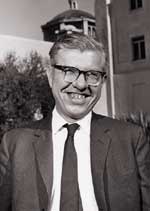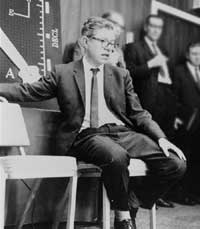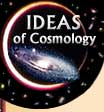|

Fred Hoyle
|
Fred
Hoyle (1915-2001)
"To
achieve anything really worth while in research, Hoyle
wrote, "it is necessary to go against the opinions of one's fellows.
To do so successfully, not merely becoming a crackpot, requires fine judgment,
especially on long-term issues that cannot be settled quickly." Early
disdain for convention and the fact that students
paid less income tax persuaded Hoyle to forego a PhD in 1939. During the
war he worked on radar and met Hermann Bondi and Tommy Gold, with whom
he would propose steady state theory in 1948. With William Fowler and
Geoffrey and  Margaret
Burbridge in the 1950s, Hoyle explained how elements more massive than
helium can be manufactured in stars. Fowler received a Nobel Prize for
the work, not shared with the more controversial Hoyle. Hoyle founded
the Institute of Theoretical Astronomy in Cambridge in 1967, but resigned
in 1973, in one of many disputes with authority. Hoyle more recently attributed
life on earth to an infall of organic matter from space and the microwave
background to electromagnetic radiation from particles formed when metallic
vapors spewed out of supernovae cooled slowly. Hoyle achieved much in
research, and also risked being judged a crackpot. Margaret
Burbridge in the 1950s, Hoyle explained how elements more massive than
helium can be manufactured in stars. Fowler received a Nobel Prize for
the work, not shared with the more controversial Hoyle. Hoyle founded
the Institute of Theoretical Astronomy in Cambridge in 1967, but resigned
in 1973, in one of many disputes with authority. Hoyle more recently attributed
life on earth to an infall of organic matter from space and the microwave
background to electromagnetic radiation from particles formed when metallic
vapors spewed out of supernovae cooled slowly. Hoyle achieved much in
research, and also risked being judged a crackpot.
|


